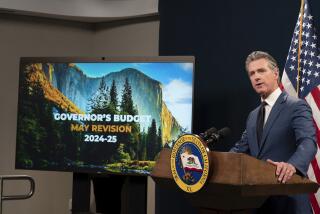Power Crisis: Give Us Facts
The lights are on, there have been no Stage 3 alerts for several days and the air of panic has eased. But California’s electricity crisis is not behind us, or even close to it. The situation is certain to get worse before it gets better.
Californians, except in public power islands like Los Angeles, can expect hours of rolling blackouts this summer unless there is a crash conservation effort. Gov. Gray Davis says consumers must cut electricity use by 10% to keep the air conditioning on this summer, yet a sense of public urgency is lacking. One indicator is a municipal vote Tuesday on whether a new power plant should be built in South Gate. Polls have the vote about 50-50, crisis or not.
The Legislature needs to move quickly on pending conservation legislation. But then what? Nothing the state has done so far shows the way to a comprehensive long-term fix for the mess created by the 1996 deregulation fiasco.
The state has certainly plunged itself into the electric power business for years to come, far deeper than it ever was as the mere regulator of the privately owned utilities. State officials are committing $20 billion or more for as long as the next 20 years without revealing to taxpayers the conditions for these expenditures or exactly how the money will be repaid.
Davis is bargaining to take control of more than 20,000 miles of electric transmission lines at a cost of up to $10 billion--an action that raises scores of questions. Will the state run this system, and pay its upkeep, for the foreseeable future? Is there any strategy for reselling it to the utilities or some other entity?
Davis and lawmakers do deserve credit for fulfilling their first responsibility: keeping the lights on even as the state’s two biggest private utilities--Southern California Edison and Pacific Gas & Electric--careened toward bankruptcy. Davis now is working on a second priority, to rescue the utilities from billions of dollars of debt amassed as wholesale power prices soared in an out-of-control market while rates were frozen by the deregulation law.
The state has also established a $10-billion revenue bond fund to buy power under long-term contracts. The state stepped in when the generating companies refused to sell more power to the near-bankrupt utilities, but the bond money won’t be available at least until May. Although the governor’s office has kept its power negotiations secret, one big energy company, Calpine, announced last week that it had agreed to sell the state $8.3 billion worth of power for up to 20 years. Meanwhile, the state is shelling out roughly $50 million a day to buy power on daily markets--a total of more than $2 billion, and doubling by May.
No one knows when or if the utilities’ credit will be restored so they can resume buying all of their power on their own. The revenue bonds may also not be sufficient to repay the state for the short-term power purchases. If not, the drain could use up much of the state’s $10-billion budget surplus.
The governor has so far had Californians’ support, but the time is approaching for him to give the people a candid appraisal of where the state stands and what power customers can expect, at least through the summer. As one observer noted, “The buds are on the trees.”
There’s an enormous bill coming due at some point for this drain on state financial resources. We as citizens should know who might have to pay, how much and for how long. Californians need to know exactly what they must do to survive the summer without devastating blackouts. Davis does no one any favor by minimizing the scope of the crisis or the fact that everyone will need to sacrifice to get through it. A long, hot summer is not far off.
More to Read
Get the L.A. Times Politics newsletter
Deeply reported insights into legislation, politics and policy from Sacramento, Washington and beyond. In your inbox three times per week.
You may occasionally receive promotional content from the Los Angeles Times.






